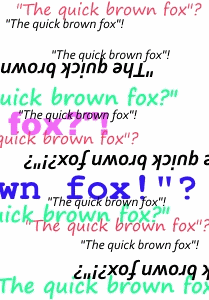 As you all know, I work with writers all over the world. This creates a special problem. It’s difficult to work with freelancers regardless. When you work with employees, everyone can be depended upon to know the company style. But that’s asking a bit much for a writer who might have a dozen clients. But I find dealing with the British variants of English to be more annoying. This is mostly because I think the British are just being difficult by insisted upon things like adding unnecessary “u” characters into words that clearly don’t need them. I’m also not keen on the use of “s” when “z” is obviously called for. The quotation marks are different.
As you all know, I work with writers all over the world. This creates a special problem. It’s difficult to work with freelancers regardless. When you work with employees, everyone can be depended upon to know the company style. But that’s asking a bit much for a writer who might have a dozen clients. But I find dealing with the British variants of English to be more annoying. This is mostly because I think the British are just being difficult by insisted upon things like adding unnecessary “u” characters into words that clearly don’t need them. I’m also not keen on the use of “s” when “z” is obviously called for. The quotation marks are different.
The British are absolutely right about quotation marks. And in practice, they are far more important than all the Us and Zs combined. There are two aspects of this. The one that most offends me is the ordering of quotation marks. It’s very possible that I will die due to a brain aneurysm because I start thinking about how we move from two to one to three when nesting quotes. The second issue is equally maddening but it doesn’t upset my sense of mathematical clarity quite as much. I am talking about, of course, the way quotation marks interact with punctuation.
Numbering Quotation Marks
The British number quotation marks the way that one would if one were simply not crazy. You could be stupid or ignorant or lazy, and it wouldn’t matter. You would decide that quoted material should go inside a single quote. If the quoted material contained quoted material, that would go inside double quotes. And if that quoted material contained its own quoted material, it would go inside triple quotes.
If, by chance, your triple quoted material contained quoted material, it would be a sign that you were brilliant, mean, or both. But in the British system, we would know that it would go inside quadruple quotes. This is, I have been told, the same way it works with the American system. But I doubt very seriously that American typesetters would have decided something that simple if this were an issue that ever came up in practice. For one thing, how is it that the sequence goes 2-1-3-4? I suspect the Americans would have decided that the proper designation would be something bizarre like five tilde marks, two quotation marks, and five more tilde marks.
There is simply no reason to go from 2 to 1 to 3. But I go along because that is the way we do it here in the good old United States of Typesetters (typesetters having more power in this country than linguists). Strangely, though, I don’t so much mind it in sentences; I more mind it when used in a scare quote or some other place where a single word has quotation marks around it. Because in that case, it really doesn’t matter. But, you know: consistency!
Quotation Marks and Periods
The British sensibly apply quotation marks to the text being quoted. Americans understand this, because we do the same thing when it comes to exclamation and question marks. We understand that the following two sentences mean very different things:
- He said “yes!”
- He said “yes”!
The placement of the exclamation marks in those two sentences dictate who is excited about him saying yes. It’s critically important.
But when it comes to the period or the comma, there is no distinction. It really doesn’t make sense to write, “He picked up ‘the book.'” It implies that the period belongs to “the book,” but it doesn’t (just as it does with the comma in this sentence). This really bugs me. The main reason is that it is almost always the case that the period or comma logically belongs outside the quotation mark. So if you just wanted to make the language as easy as possible (and I do), you should always have them outside and not inside the quotation marks.
But the reason we do this is because typesetters of one time thought inside looked better than outside. Undoubtedly, they would have done the same thing with the exclamation and question marks as well, but there are too many cases where this would lead to utter confusion.
We Must Be Wrong Together
So I have to apologize to my writers who learned British English. On matters having to do with quotation marks, they are totally right. And I am forced to “correct” them. It sucks. But there is nothing I can do. I have written our style guide (and continue to expand it). In theory, I would stipulate that we do things the logical British way. But practically, I can’t. I have to maintain a style guide that makes sense to the reader, even though the reader is wrong.
For example, the style guide says:
Copy editing is really not concerned with making sure the copy is correct. It is concerned with making sure the copy seems correct to the intelligent and “educated” reader. And really, we use a stupid approach to quotation marks because the United States has a bigger GDP than the United Kingdom. It’s sad.
